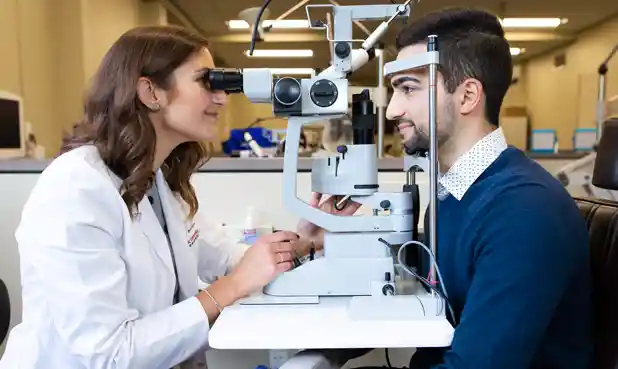When it comes to eye health, most people are familiar with the term “optometrist.” An optometrist is a healthcare professional who specializes in examining, diagnosing, and treating visual problems and eye diseases. They play a crucial role in ensuring that individuals maintain good eye health and can see clearly. This article will explore the various aspects of optometry, including the education and training required to become an optometrist, the services they provide, and their importance in the healthcare system.
What is an Optometrist?
An optometrist is a licensed professional who provides a range of eye care services. Unlike ophthalmologists, who are medical doctors specializing in eye surgery and the treatment of eye diseases, optometrists primarily focus on vision care. They are trained to perform comprehensive eye exams, prescribe corrective lenses, and diagnose and manage certain eye conditions. Optometrists play a key role in promoting eye health and preventing vision-related issues.
The Importance of Optometrists
Optometrists are essential in maintaining public health. Vision is one of our most critical senses, and any impairment can significantly affect daily life. Regular eye examinations by an optometrist can help detect vision problems early, leading to more effective treatments. Additionally, optometrists educate patients on proper eye care, helping to prevent conditions such as glaucoma, cataracts, and macular degeneration.
Education and Training of an Optometrist
Educational Pathway
Becoming an optometrist requires extensive education and training. The typical pathway includes the following steps:
- Undergraduate Degree: Prospective optometrists must first complete an undergraduate degree, often with a focus on science-related fields such as biology, chemistry, or physics. This foundational knowledge is crucial for understanding the complexities of the human eye and vision.
- Optometry School: After obtaining an undergraduate degree, students must apply to an accredited optometry school. Optometry programs typically last four years and include both classroom instruction and clinical training. Students learn about optics, vision science, eye anatomy, and the diagnosis and treatment of eye diseases.
- Licensure: After completing their education, graduates must pass a national board examination and obtain a state license to practice as an optometrist. Each state has its licensing requirements, which may include additional exams or continuing education.
Continuing Education
To maintain their licenses, optometrists must engage in continuing education throughout their careers. This requirement ensures that they stay updated on the latest advancements in eye care, treatment techniques, and emerging technologies.
Services Provided by Optometrists
Optometrists offer a wide range of services to their patients. These include:
Comprehensive Eye Exams
One of the primary functions of an optometrist is to conduct thorough eye examinations. During an eye exam, the optometrist evaluates the patient’s vision, checks for refractive errors (such as nearsightedness or farsightedness), and assesses the overall health of the eyes. This examination typically involves:
- Visual Acuity Tests: These tests measure how well a person can see at different distances. Patients may read letters from an eye chart to determine their visual clarity.
- Refraction Assessment: This process helps determine the appropriate prescription for glasses or contact lenses. The optometrist uses a phoropter to present various lens options to the patient, asking them which lenses provide clearer vision.
- Eye Health Evaluation: The optometrist examines the front and back of the eye using specialized instruments. This assessment helps detect conditions like cataracts, glaucoma, and diabetic retinopathy.
Prescription of Corrective Lenses
Optometrists are authorized to prescribe glasses and contact lenses based on the results of the eye exam. They take into account the patient’s lifestyle, preferences, and visual needs when recommending the best type of corrective lenses.
Diagnosis and Management of Eye Diseases
Optometrists are trained to diagnose and manage various eye conditions, including:
- Glaucoma: This condition involves increased pressure in the eye, which can damage the optic nerve. Optometrists can monitor intraocular pressure and prescribe medications to help control the condition.
- Diabetic Retinopathy: Patients with diabetes may develop vision problems due to damage to the blood vessels in the retina. Optometrists can detect early signs of diabetic retinopathy and refer patients to specialists for further treatment.
- Dry Eye Syndrome: This common condition occurs when the eyes do not produce enough tears or when the tears evaporate too quickly. Optometrists can recommend treatments such as artificial tears or lifestyle changes to alleviate symptoms.
Vision Therapy
Some optometrists specialize in vision therapy, a form of rehabilitation for individuals with visual-motor or perceptual-cognitive issues. This therapy can help improve visual skills, such as eye coordination and tracking, particularly in children with learning disabilities.
Pediatric Eye Care
Optometrists also provide essential eye care for children. Early detection of vision problems in children is crucial for their development and academic success. Optometrists can conduct vision screenings and exams tailored to the needs of young patients, ensuring that any issues are addressed promptly.
Geriatric Eye Care
As individuals age, they may experience a range of vision changes and eye conditions. Optometrists are trained to provide specialized care for older adults, addressing issues like cataracts, macular degeneration, and presbyopia (age-related difficulty in seeing close objects).
The Role of Optometrists in Public Health
Optometrists contribute significantly to public health initiatives. They participate in community outreach programs to educate the public about eye health, the importance of regular eye exams, and preventive measures to protect vision. By raising awareness about eye-related issues, optometrists help reduce the incidence of vision problems and improve overall community health.
How to Choose the Right Optometrist
Finding the right optometrist is essential for receiving quality eye care. Here are some tips to help you choose the best optometrist for your needs:
1. Check Credentials
Ensure that the optometrist is licensed and has completed the necessary education and training. You can check their credentials online or ask the optometrist directly.
2. Consider Experience
Look for an optometrist with experience in treating your specific eye conditions or concerns. An experienced optometrist is more likely to provide accurate diagnoses and effective treatments.
3. Read Reviews
Check online reviews and ratings from previous patients to get an idea of the optometrist’s reputation and quality of care. Positive feedback can indicate a reliable and caring professional.
4. Evaluate Office Environment
Visit the optometrist’s office to assess the environment. A clean, well-organized office with friendly staff can enhance your overall experience.
5. Ask About Insurance
Confirm whether the optometrist accepts your health insurance plan. Understanding the costs involved will help you make an informed decision.
Frequently Asked Questions About Optometrists
1. What is the difference between an optometrist and an ophthalmologist?
An optometrist focuses on vision care and eye exams, while an ophthalmologist is a medical doctor who specializes in eye surgery and the treatment of eye diseases.
2. How often should I see an optometrist?
It is generally recommended to have an eye exam every one to two years. However, individuals with existing eye conditions or risk factors may need more frequent visits.
3. Can optometrists perform surgery?
Optometrists are not typically trained to perform surgical procedures. However, some may be authorized to perform certain minor procedures, such as the removal of foreign bodies from the eye.
4. What should I expect during an eye exam?
During an eye exam, the optometrist will evaluate your vision, check for refractive errors, assess eye health, and discuss any concerns you may have. The entire process usually takes about 30 to 60 minutes.
5. Do I need a referral to see an optometrist?
In most cases, you do not need a referral to see an optometrist. However, if you have specific concerns or conditions, it may be beneficial to consult with your primary care physician for guidance.
The Future of Optometry
As technology continues to advance, the field of optometry is also evolving. New diagnostic tools, treatment options, and telehealth services are becoming increasingly available, enhancing the quality of eye care. Optometrists are adapting to these changes, incorporating new technologies to improve patient outcomes and streamline their practices.
Conclusion
In summary, optometrists play a vital role in maintaining eye health and providing essential vision care services. Their extensive education and training equip them to diagnose and manage various eye conditions, prescribe corrective lenses, and promote overall eye health. Regular visits to an optometrist are crucial for preventing vision problems and ensuring that individuals can enjoy a high quality of life. By understanding the role of an optometrist and the services they provide, you can make informed decisions about your eye care and prioritize your visual health.













